PONTIAC BONNEVILLE 1993 Owners Manual
Manufacturer: PONTIAC, Model Year: 1993, Model line: BONNEVILLE, Model: PONTIAC BONNEVILLE 1993Pages: 322, PDF Size: 16.31 MB
Page 181 of 322
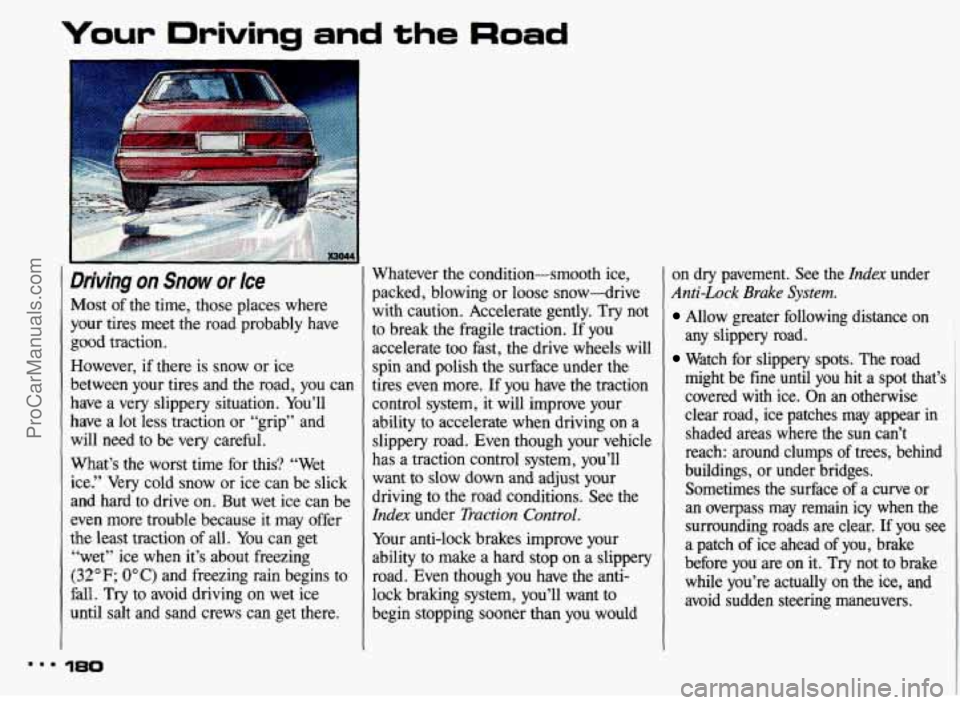
Your Driving and the Road
Driving on Snow or Ice
Most of the time, those places where
your tires meet the road probably have
good traction.
However, if there
is snow or ice
between your tires and the road, you can
have a
very slippery situation. You’ll
have a lot
less traction or “grip” and
will need to be very
careful.
What’s the worst time for this? “Wet
ice.”
Very cold snow or ice can be slick
and hard to drive on. But wet ice can
be
even more trouble because it may offer
the least traction of all. You can get
“wet” ice when it’s about freezing
(32°F; OOC) and freezing rain begins to
fall.
Try to avoid driving on wet ice
until salt and sand crews can get there. Whatever
the condition-smooth ice,
packed, blowing or loose snow-drive
with caution. Accelerate gently.
Try not
to break the fragile traction.
If you
accelerate too fast, the drive wheels will
spin and polish the surface under the
tires even more.
If you have the traction
control
system, it will improve your
ability to accelerate when driving on a
slippery road. Even though your vehicle
has a traction control system, you’ll
want
to slow down and adjust your
driving to the road conditions. See the
Index under Traction Control.
Your anti-lock brakes improve your
ability to make a hard
stop on a slippery
road. Even though you have the anti-
lock braking
system, you’ll want to
begin stopping sooner than you would on dry pavement. See the
Idex under
Anti-Lock Brake System.
Allow greater following distance on I
any slippery road.
Watch
for slippery spots. The road
might be fine until you
hit a spot that’s
covered with ice.
On an otherwise
clear road, ice patches may appear
in
shaded areas where the sun can’t
reach: around clumps
of trees, behind
buildings,
or under bridges.
Sometimes the surface of a
curve or
an overpass may remain icy when the
surrounding
roads are clear. If you see
a patch of ice ahead of you, brake
before you are on it.
Try not to brake
while you’re actually on the ice, and
avoid sudden steering maneuvers.
..I 180
ProCarManuals.com
Page 182 of 322
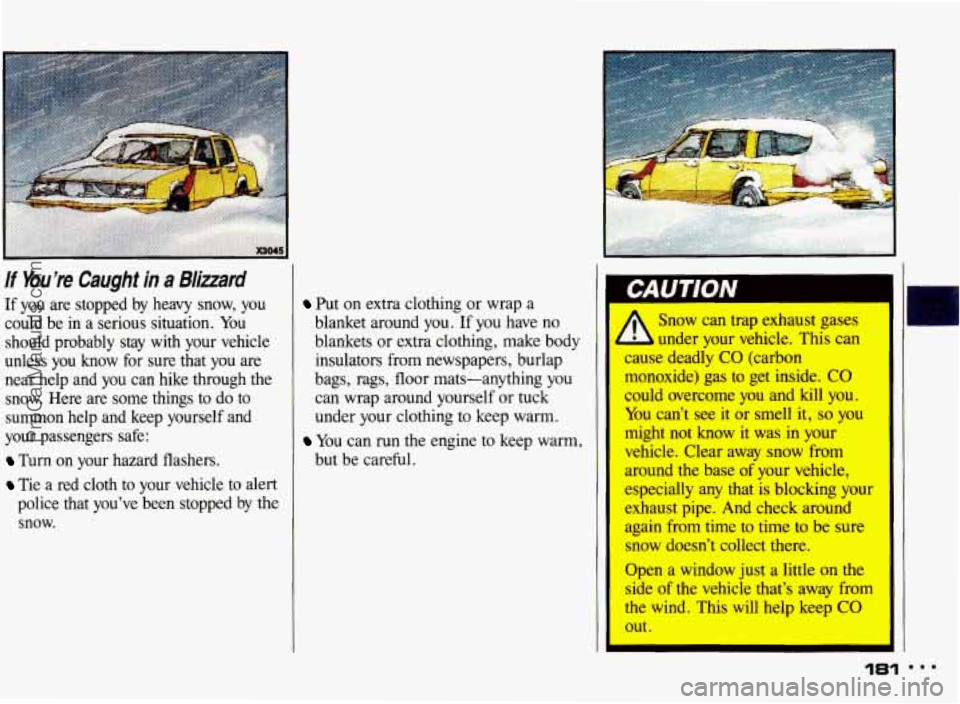
If You’re Caught in a Bli’ard
If you are stopped by heavy snow, you
could be in a serious situation.
You
should probably stay with your vehicle
unless you know for sure that
you are
near help and you can hike through the
snow. Here are some things to
do to
summon help and keep yourself and
your passengers safe:
Turn on your hazard flashers.
Tie a red cloth to your vehicle to alert
police that you’ve been stopped by the
snow.
Put on extra clothing or wrap a
blanket around you.
If you have no
blankets or extra clothing, make body
insulators from newspapers, burlap
bags, rags, floor mats-anything you
can wrap around yourself
or tuck
under your clothing to keep warm.
but be careful.
You can run the engine to keep warm, cause deadly
CO (carbon
monoxide) gas to get inside.
CO
could overcome you and kill you.
You can’t see it or smell it, so you
might not know
it was in your
vehicle. Clear away snow from
around the base of your vehicle,
especially any that is blocking your
exhaust pipe. And check around
again from time to time to be
sure
snow doesn’t collect there.
Open a window just a little on the
side of the vehicle that’s away from
the wind. This
will help keep CO
out.
ProCarManuals.com
Page 183 of 322
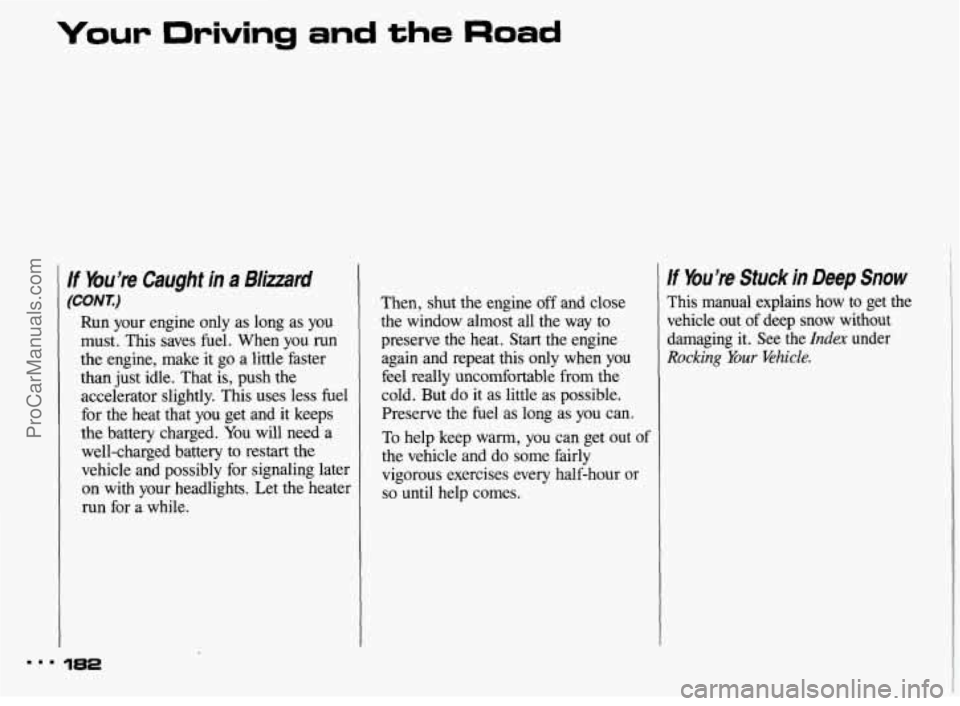
Your Driving and the Road
If bu’re Caught in a Blizzard
(CONT)
Run your engine only as long as you
must. This saves fuel. When you run
the engine, make it go a little faster
than just idle. That
is, push the
accelerator slightly. This uses less fuel
for the heat that you get and it keeps
the battery charged. You will need a
well-charged battery to restart the
vehicle and possibly for signaling later
on with your headlights. Let the heater
run for a while. Then,
shut the engine off and close
the window almost all the way to
preserve the heat.
Start the engine
again
and repeat this only when you
feel really uncomfortable from the
cold. But do it as little as possible.
Preserve the fuel as long as you can.
To help keep warm, you can get out of
the vehicle and do some fairly
vigorous exercises every half-hour
or
so until help comes.
If You’re Stuck in Deep Snow
This manual explains how to get the
vehicle out of deep snow without
damaging it. See the
Index under
Rocking Your Whicle.
ProCarManuals.com
Page 184 of 322
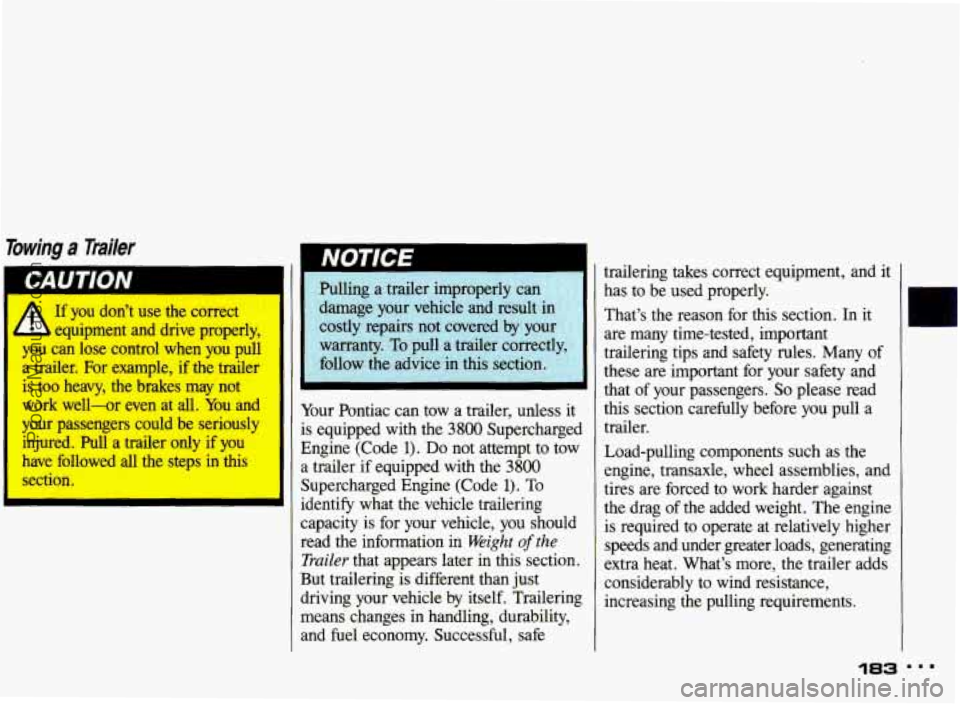
Towing a Tmiler
I
If you don't use the correct
equipment and drive properly,
you can lose control when you pull
a trailer. For example, if the trailer
is too heavy, the brakes may not
work well-or even at all. You and
your passengers could be seriously injured. Pull a trailer only if you
have followed all the steps in this
section.
NOTICE
I I; Pulling a trailer improperly can : __
damage your vehicle and result in' ;'
costly repairs not covered by your
follow the advice in this section.
Your Pontiac can tow a trailer, unless it
is equipped with the
3800 Supercharged
Engine (Code
1). Do not attempt to tow
a trailer
if equipped with the 3800
Supercharged Engine (Code 1). To
identify what the vehicle trailering
capacity is for your vehicle,
you should
read the information in
Weight of the
Trailer that appears later in this section.
But trailering is different than just
driving your vehicle by itself. Trailering
means changes in handling, durability,
and fuel economy. Successful, safe trailering
takes correct equipment, and it
has to be used properly.
That's the reason for this section.
In it
are many time-tested, important
trailering tips and safety rules. Many
of
these are important for your safety and
that of your passengers.
So please read
this section carefully before you pull a
trailer.
Load-pulling components such as the
engine, transaxle, wheel assemblies, and
tires are forced to work harder against
the drag of the added weight. The engine
is required to operate at relatively higher
speeds and under greater loads, generating
extra heat. What's more, the trailer adds
considerably to wind resistance,
increasing the pulling requirements.
ProCarManuals.com
Page 185 of 322
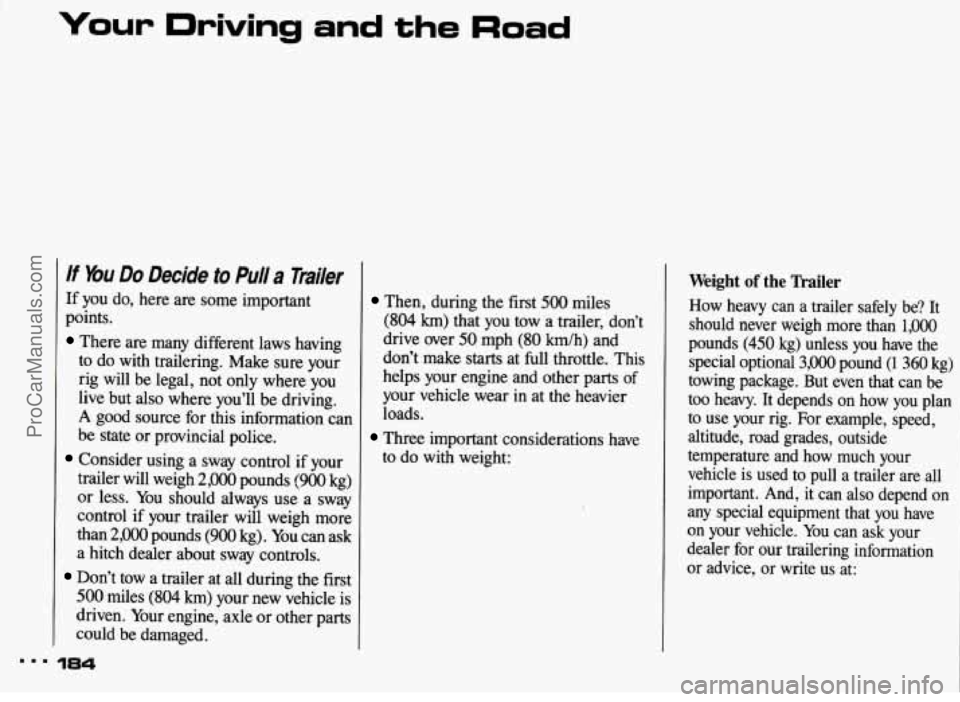
Your Driving and the Road
If bu Do Decide to Pulla Trailer
If you do, here are some important
points.
There are many different laws having
to do with trailering. Make sure your
rig will be legal, not only where you
live but also where you’ll be driving.
A good source for this information can
be
state or provincial police.
trailer will weigh
2,000 pounds (900 kg)
or less. You should always use a sway
control if your trailer will weigh more
than
2,000 pounds (900 kg). You can ask
a hitch dealer about sway controls.
Don’t tow a trailer at all during the first
500 miles (804 km) your new vehicle is
driven. Your engine, axle or other parts
could be damaged.
Consider using a sway control if your
Then, during the first 500 miles
(804 km) that you tow a trailer, don’t
drive over
50 mph (80 km/h) and
don’t make
starts at full throttle. This
helps your engine and other parts of
your vehicle wear in at the heavier
loads.
Three important considerations have
to do with weight:
Weight of the Trailer
How heavy can a trailer safely be? It
should never weigh more than
1,000
pounds (450 kg) unless you have the
special optional
3,000 pound (1 360 kg)
towing package. But even that can
be
too heavy. It depends on how you plan
to use your rig. For example, speed,
altitude, road grades, outside
temperature and how much your
vehicle is
used to pull a trailer are all
important. And, it can also depend on
any special equipment that you have
on your vehicle. You can ask your
dealer for our trailering information
or advice, or write us at:
mmm 184
ProCarManuals.com
Page 186 of 322
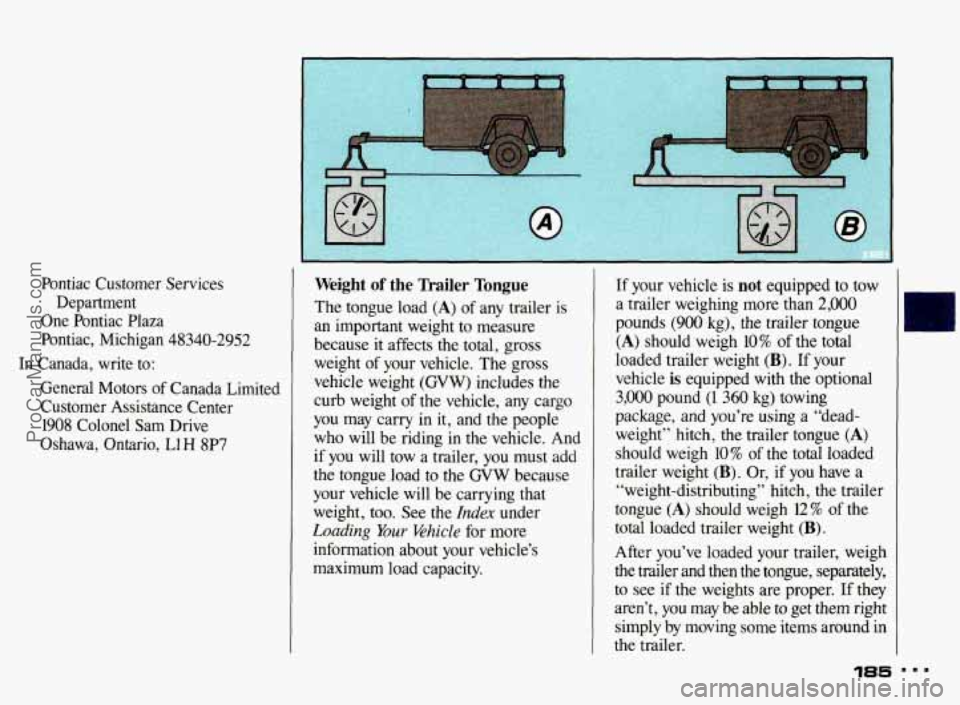
Pontiac Customer Services Department
One Pontiac Plaza
Pontiac, Michigan 48340-2952
In Canada, write to:
General Motors of Canada Limited
Customer Assistance Center 1908 Colonel Sam Drive
Oshawa, Ontario,
L1H 8P7
Weight of the nailer Tongue
The tongue load (A) of any trailer is
an important weight to measure
because it affects the total, gross
weight of your vehicle. The gross
vehicle weight
(GVW) includes the
curb weight
of the vehicle, any cargo
you may carry in it, and the people
who will
be riding in the vehicle. And
if you will tow a trailer, you must add
the tongue load to the
GVW because
your vehicle will be carrying that
weight, too.
See the Index under
Loading Your &hide for more
information about your vehicle’s
maximum load capacity.
If your vehicle is not equipped to tow
a trailer weighing more than
2,000
pounds (900 kg), the trailer tongue
(A) should weigh 10% of the total
loaded trailer weight
(B). If your
vehicle
is equipped with the optional
3,000 pound
(1 360 kg) towing
package, and you’re using a “dead-
weight” hitch, the trailer tongue
(A)
should weigh 10% of the total loaded
trailer weight
(B). Or, if you have a
“weight-distributing” hitch, the trailer
tongue
(A) should weigh 12% of the
total loaded trailer weight
(B).
After you’ve loaded your trailer, weigh
the trailer and then the tongue, separately,
to see if the weights are proper.
If they
aren’t,
you may be able to get them right
simply by moving some items around in
the trailer.
185
ProCarManuals.com
Page 187 of 322
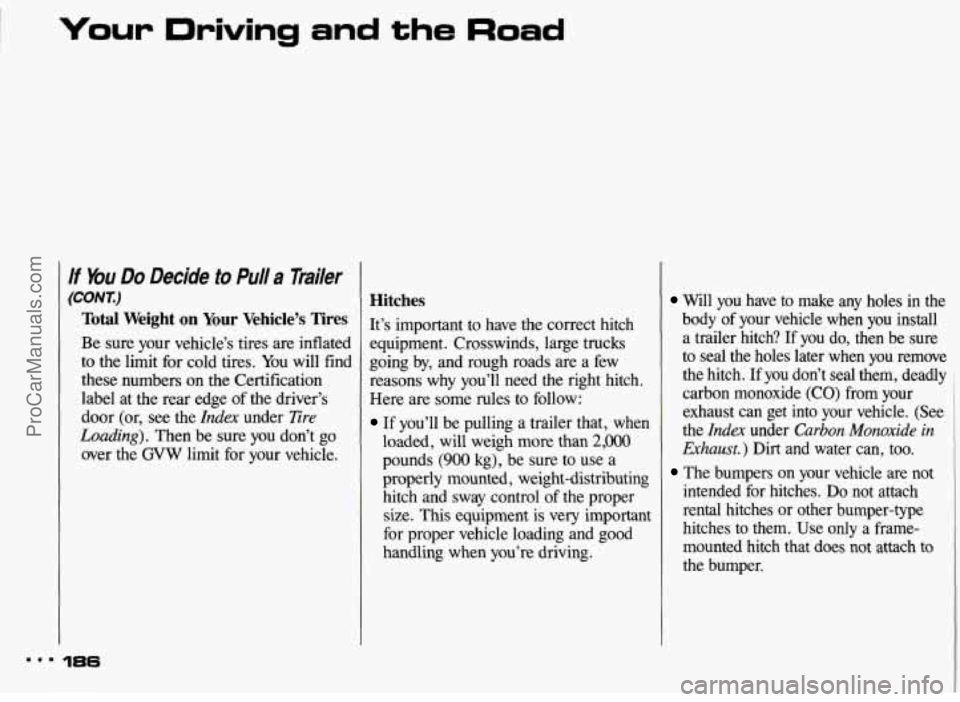
Your Driving and the Road
I4
If bu Do Decide to Pull a Trailer
(CONT.)
Total Weight on Your Vehicle’s Tires
Be sure your vehicle’s tires are inflated
to the limit for cold tires. You will find
these numbers on the Certification
label at the rear edge of the driver’s
door (or, see the
Index under 7ire
Loading).
Then be sure you don’t go
over the
GVW limit for your vehicle.
186
Hitches
It’s important to have the correct hitch
equipment. Crosswinds, large trucks
going by, and rough roads are a
few
reasons why you’ll need the right hitch.
Here are some rules to follow:
If you’ll be pulling a trailer that, when
loaded, will weigh more than 2,000
pounds (900 kg), be sure to use a
properly mounted, weight-distributing
hitch and sway control
of the proper
size. This equipment is very important
for proper vehicle loading
and good
handling when you’re driving.
Will you have to make any holes in the
body of your vehicle, when you install
a trailer hitch?
If you do, then be sure
to seal the holes later when you remove
the hitch.
If you don’t seal them, deadly
carbon monoxide
(CO) from your
exhaust can get into your vehicle. (See
the
Index under Carbon Monoxide in
Exhaust.) Dirt and water can, too.
The bumpers on your vehicle are not
intended for hitches. Do not attach
rental hitches or other bumper-type
hitches to them. Use only a frame-
mounted hitch that does not attach to
the bumper.
ProCarManuals.com
Page 188 of 322
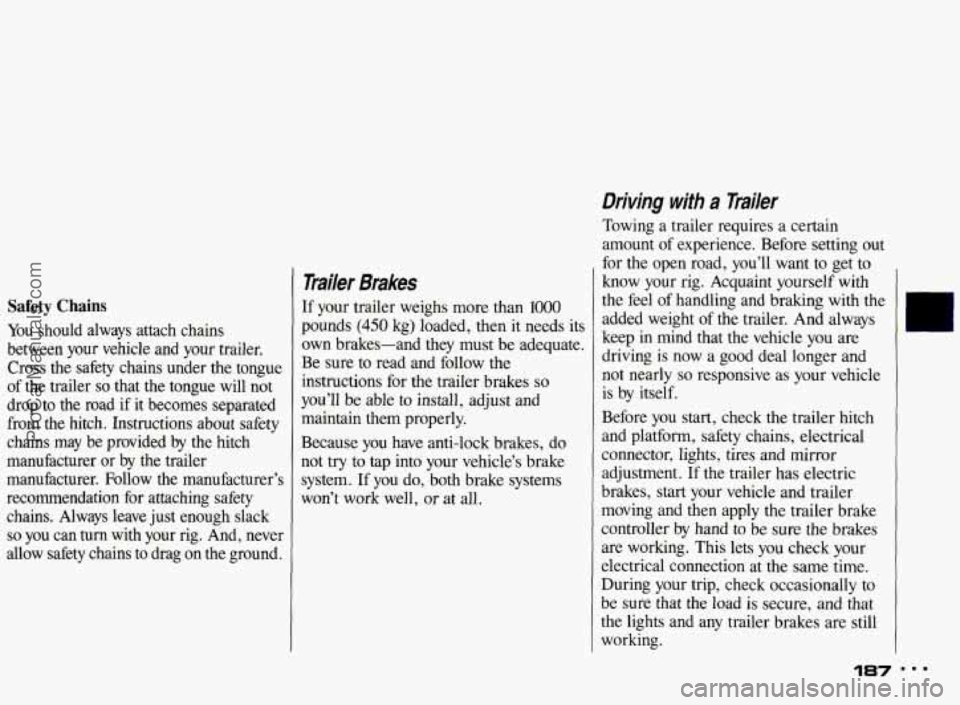
Driving witb a Traiiler
Safety Chains
You should always attach chains
between your vehicle and your trailer.
Cross the safety chains under the tongue
of the trailer
so that the tongue will not
drop to the road if it becomes separated
from the hitch. Instructions about safety
chains may be provided by the hitch
manufacturer or by the trailer
manufacturer. Follow the manufacturer’s
recommendation for attaching safety
chains. Always leave just enough slack
so you can turn with your rig. And, never
allow safety chains
to drag on the ground.
Tiai/er Brakes
If your trailer weighs more than 1000
pounds (450 kg) loaded, then it needs its
own brakes-and they must be adequate.
Be sure to read and follow the
instructions for the trailer brakes
so
you’ll be able to install, adjust and
maintain them properly.
Because you have anti-lock brakes, do
not
try to tap into your vehicle’s brake
system. If you do, both brake systems
won’t work well, or at all. Towing a
trailer requires
a certain
amount of experience. Before setting out
for
the open road, you’ll want to get to
know your rig. Acquaint yourself with I
the feel of handling and braking with the
added weight of the trailer. And always
keep in mind that the vehicle you are
driving
is now a good deal longer and
not nearly
so responsive as your vehicle
is by itself.
Before you
start, check the trailer hitch
and platform, safety chains, electrical
connector, lights, tires and mirror
adjustment.
If the trailer has electric
brakes, start your vehicle and trailer
moving and then apply the trailer brake
controller by hand to be sure the brakes
are working. This lets you check your
electrical connection at the same time.
During your trip, check occasionally to
be sure that the load is secure,
and that
the lights and any trailer brakes are still
working.
ProCarManuals.com
Page 189 of 322
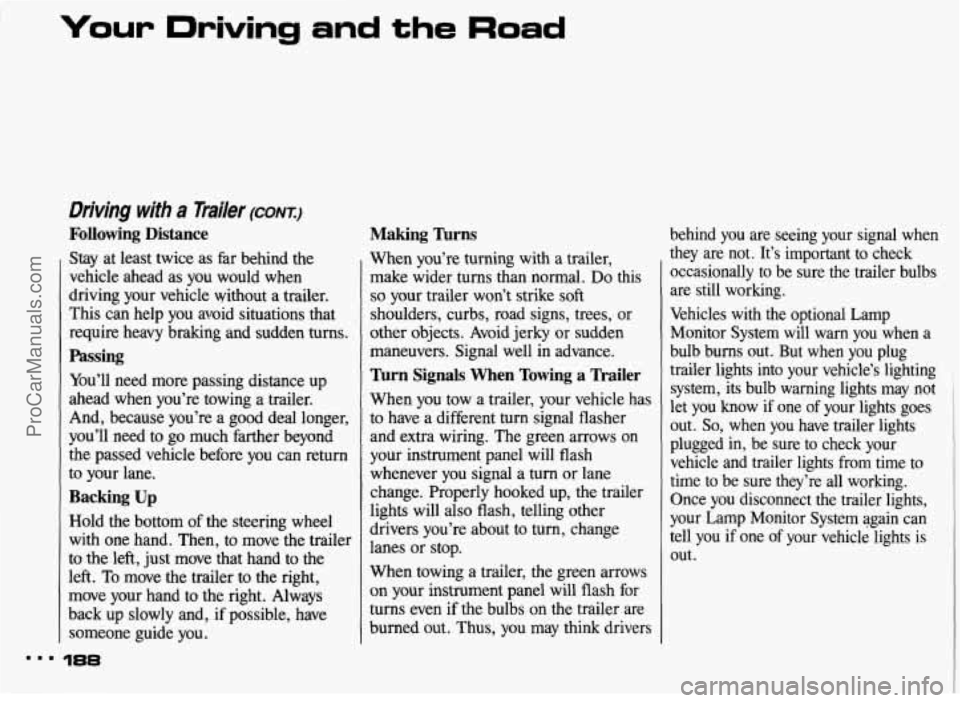
‘Your Driving and the Road
Driving with a Tmiler (CONX)
Following Distance
Stay at least twice as far behind the
vehicle ahead as you would when
driving your vehicle without a trailer.
This can help you avoid situations that
require heavy braking and sudden
turns.
You’ll need more passing distance up
ahead when you’re towing a trailer.
And, because you’re a good deal longer,
you’ll need to go much farther beyond
the passed vehicle before you can return
to your lane.
Backing Up
Hold the bottom of the steering wheel
with one hand. Then, to move the trailer
to
the left, just move that hand to the
left. To move the trailer to the right,
move your hand to the right. Always
back up slowly and, if possible, have
someone guide you.
188
Passing
Making ’hrns
When you’re turning with a trailer,
make wider turns than normal.
Do this
so your trailer won’t strike soft
shoulders, curbs, road signs, trees, or
other objects. Avoid jerky or sudden
maneuvers. Signal well in advance.
Turn Signals When Towing a Trailer
When you tow a trailer, your vehicle has
to have a different turn signal flasher
and extra wiring. The green arrows on
your instrument panel will flash
whenever you signal a turn or lane
change. Properly hooked up, the trailer
lights will also flash, telling other
drivers you’re about to turn, change
lanes or stop.
When towing a trailer, the green arrows
on your instrument panel will flash for
turns even if the bulbs on the trailer are
burned out. Thus, you may think drivers behind you
are seeing your signal when
they are not. It’s important to check
occasionally to be sure the trailer bulbs
are still working.
Vehicles with the optional Lamp Monitor System will warn you when a
bulb burns out. But when you plug
trailer lights into your vehicle’s lighting
system, its bulb warning lights may not
let you know if one
of your lights goes
out.
So, when you have trailer lights
plugged in, be sure to check your
vehicle and trailer lights from time to
time to be sure they’re all working. Once you disconnect the trailer lights,
your Lamp Monitor System again can
tell you if one
of your vehicle lights is
out.
ProCarManuals.com
Page 190 of 322
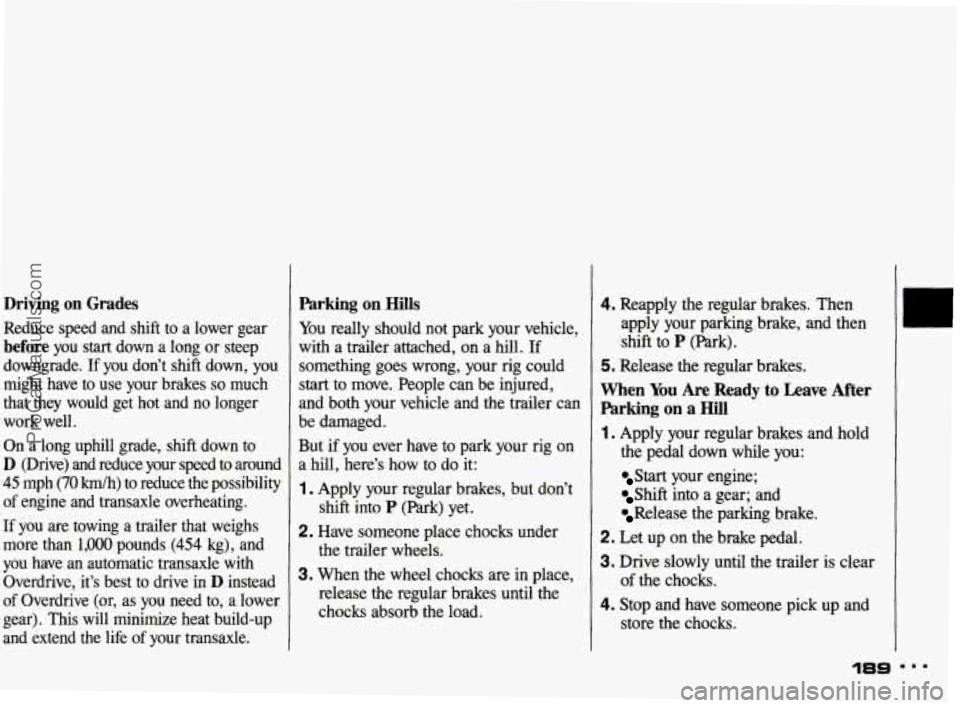
Driving on Grades
Reduce speed and shift to a lower gear
before you start down a long or steep
downgrade. If you don’t shift down, you
might have to use your brakes
so much
that they would get hot and no longer
work well.
On a long uphill grade, shift down to
D (Drive) and reduce your speed to around
45 mph (70 km/h) to reduce the possibility
of engine and transaxle overheating.
If you are towing a trailer that weighs
more than
1,000 pounds (454 kg), and
you have an automatic transaxle with
Overdrive, it’s best
to drive in D instead
of Overdrive (or, as you need to, a lower
gear). This will minimize heat build-up
and extend the life
of your transaxle.
Parking on Hills
You really should not park your vehicle,
with a trailer attached, on a hill. If
something goes wrong, your rig could
start to move. People can be injured,
and both your vehicle and the trailer can
be damaged.
But if you ever have to park your rig on
a hill, here’s how to do it:
1. Apply your regular brakes, but don’t
shift into
P (Park) yet.
2. Have someone place chocks under
the trailer wheels.
3. When the wheel chocks are in place,
release the regular brakes until the
chocks absorb the load.
4. Reapply the regular brakes. Then
apply your parking brake, and then
shift to
P (Park).
5. Release the regular brakes.
When You Are Ready to Leave After
Parking on a Hill
1, Apply your regular brakes and hold
the pedal down while you:
Start your engine;
Shift into a gear; and
Release the parking brake.
2. Let up on the brake pedal.
3. Drive slowly until the trailer is clear
4. Stop and have someone pick up and
of the chocks.
store the chocks.
ProCarManuals.com